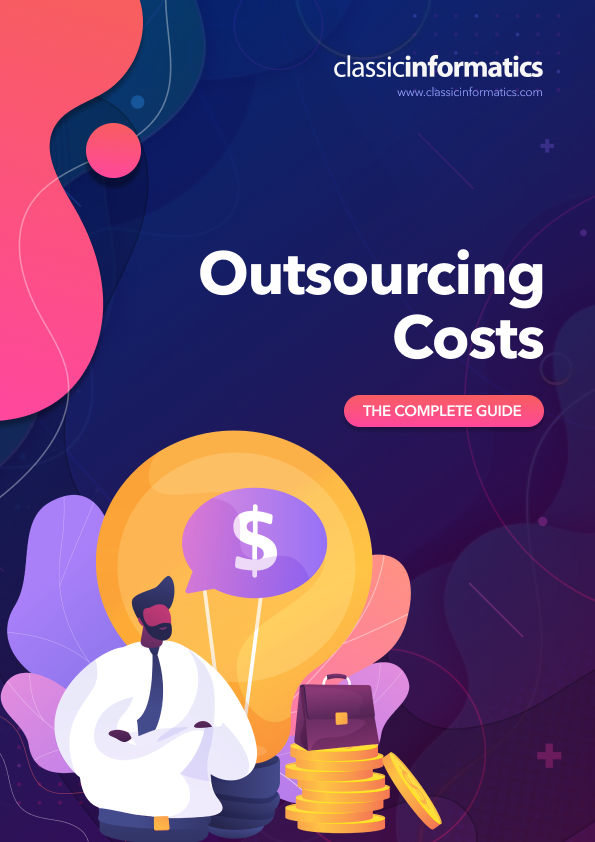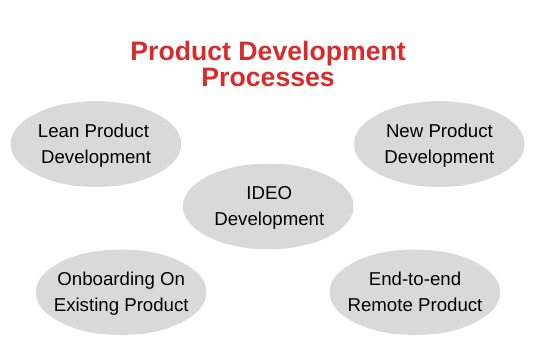With an understanding of the product development process, startups face the dilemma of choosing between in-house development and outsourcing the product development. They have several questions to ask and are unsure whether they should hire in-house developers, testers, QA analysts, product managers, and others to build the product or outsource it to an expert offshore software development company.
There are several ways you can find out whether you should outsource or keep your product development in-house. Here, we have discussed:
- The reasons to keep in-house or outsource
- The challenges startups face in choosing either of the approaches
Reasons To Outsource Product Development
We know by now that product development is a tedious process. It involves extensive steps and many iterations. Even then, there may be errors that might delay the product launch. Without a dedicated team of product developers, testers, designers, and others, a successful product is hard to imagine. This can easily overwhelm any startup. Hence, many startups resort to outsourcing product development. But overwhelming with tech is not the only reason why startups outsource. Here are some common reasons why startups outsource their product.
Reason 1. You Get An Experienced Partner
The first perk is obviously the experience that you get. An external technology partner can add the much-needed expertise that young entrepreneurs and startups lack. This means that an outsourcing company can add the skills and experience required to build a product. While you are starting out in the industry, an external company has already worked on similar products.
Irrespective of the product idea you have, they might’ve already developed something similar in the past. This provides you an edge in the game and your lack of experience is balanced out with their expertise.
Reason 2. You Get The Freedom To Scale Up Or Down
Need the core developer for writing the product codes? Or the complete team to help with ideation, research, development, and launch? A product development company takes care of it all. You need not worry about hiring new developers or keeping some developers in spare for ‘when you may need them’.
It is really easy to scale your product team up and down when you are working with an outsourcing company. In fact, you don’t even have to worry about scaling. The company analyzes your product’s requirements and keeps adding new technology experts as per the requirements.
Reason 3. You Save Costs
This is a given in outsourcing. There are several costs involved when you keep the development in-house. Be it the system setup, IT infrastructure, physical environment/space to work, and various other things, there are many costs involved in product development in-house. And we all know how the budget works in startups. Whether you have crowdfunded, gotten an investment from VC, or taken loans, each penny counts in startups.
You cannot go lavish with the infrastructure. But at the same time, you cannot compromise on the quality of the product. Outsourcing saves money by acting as a viable and cost-effective solution to your needs with capped financial commitments.

Reason 4. You Get Faster Development
In a market where getting outcompeted is not a rarity, faster development is the need of the hour for any startup. They need to build their product and they need to do it fast. Else they would be another name in the list of companies who were slow enough to see their innovative ideas being implemented by someone else.
With an outsourcing company, speed is something that is guaranteed. They have different sprints for development and promise to get the product out within the committed time. You can accelerate your time to market with outsourcing.
- They already have the product team ready, so you save time on putting together a team.
- They have the experience, so you save time on trials and errors.
- They have a tried and tested strategy, so you save time on unwanted delays.
Reason 5. You Find The Dream Development Team
It isn’t easy to find the right team that is fit for your product. You might not find the technology experts. You might have trouble finding developers in your budget. You might even take days to put up the dream product team. Outsourcing saves you all of this.
Most product companies analyze the startup’s budget, requirements, and product idea to come up with the best experts. You have the freedom to choose the ones you deem fit. Moreover, you do not compromise with the specialties. Finding local talent is hard. And outsourcing solves this problem too. With an offshore product development company, you get the expertise you need to build the product and overcome any challenge that may hinder its launch.
Reason 6. You Have A Happier Founding Team
The startup founding team has the passion and the mindset where everyone wants to do everything on their own. And sure they can be a jack of all trades, but can only be masters of one. And if they try to be masters at all, they are only going to end up being frustrated and overwhelmed. With an external product development team, your startup founding team is much happier and satisfied with the results they see at their work. They have experts handling the product development while they manage the bigger goals.
Challenges In Outsourcing
While we all sing hymns in praises of outsourcing, there are some challenges that might keep the startups from going the outsourcing way. These challenges are nothing but some obstacles that make outsourcing a bit demanding. Nonetheless, the benefits of outsourcing stay the same. If you are wondering why, despite all the benefits, some startups keep the product development in-house, here are some challenges that make them stray away from outsourcing.
Challenge 1. Miscommunication
Talking to a team face to face versus talking to them virtually is undoubtedly different. One can go to the desk and convey any thoughts or ideas about the progress in the development when working in the same physical location. Working with remote teams means there can be several things unsaid, missed out, assumed, or even misunderstood. There can be some miscommunications that can lead to the failure of any outsourcing venture.
However, working remotely for the past year has made remote collaboration seamless. Documentation, along with remote working tools, can help avoid any miscommunication.
Challenge 2. Losing Project Control
Young entrepreneurs are always too passionate about the product and want full control over each step. However, outsourcing doesn’t work this way. It needs both parties to have full trust in each other. Entrepreneurs need to put their faith in the outsourcing company and let their work their magic with the product. But many entrepreneurs see this as losing their control over the project. And this is certainly a challenge. Many startups might lose control if the outsourcing contract is not fool-proof.
The outsourcing contract should define the extent to which the outsourcing company can exert control over the project. The decision-making and the last say should also be defined to avoid losing any project control.
Challenge 3. Unfulfilled Expectations
Considering the experience and expertise of the outsourcing company, it wouldn’t be wrong for a startup to have really high expectations from the deal. Many think that once they have joined hands with an outsourcing company, everything will be taken care of by them. These unrealistic expectations can lead to project failure. You might expect something from them which is not covered in the contract. None would take care of the issue and it might escalate.
Discussing everything in detail is imperative to avoid such unfulfilled expectations. Get an estimate of the budget and the time to eliminate any unsaid expectations.
Challenge 4. IP Security
Online is always risky. No matter how many VPNs you set up or secure your data, there will always be a risk hinging over the head. For startups, their intellectual property, their idea, is their main treasure. But this needs to be shared with the remote tech team and product developers via several online tools. Other properties like trade secrets, business plans, etc., also need to be shared. There will always be a certain amount of risk to the IP security by hackers and even ransomware.
The seriousness of protecting the IP should be explicitly mentioned in the contract. Your IP is your property and one should sign a non-disclosure agreement and other legally binding documents to protect it.
Challenge 5. Budget Spike
If the budget, scope of the project, and the output from the outsourcing partnership are not clearly defined, the budget can easily escalate in outsourcing. They might have to spend more time on the project leading to extra charges.
Reasons To Keep Product Development In-House
While outsourcing proves to be a cost-effective solution, there are several reasons why startups like to keep it in-house. This means the founding team hires developers in-house and arranges for working space for everyone to work together on building the product. They have tech teams working directly for them with shared cultural values and working methodologies. Let’s take a look at some of the reasons why startups take the in-house development route.
Reason 1. Your Product’s Foundation Is On Technology
This is one of the main reasons why most startups opt for in-house development instead of outsourcing it. Their startup product is based majorly on the technology or tech that is proprietary to their startup. There is a large section of startups that have technology as the core proposition or offer.
For example, you are offering API development using a specific framework. Your main audience is tech experts and you cannot compromise on it at any cost. You cannot hand this over to an outsourcing company as tech is at the center. But when you are working with a product like Uber, tech is at the second level and your main offering is to help commuters/travelers find rides.
When technology is at the core and you are targeting the tech experts with a unique implementation, keeping the product development in-house is the way to go.
Reason 2. You Want Full Control Of Product Development
Control is one thing that startups worry the most about. Entrepreneurs, as we know, are really passionate about their product and are even ready to wear many hats just to keep things in their control. Outsourcing snatches this control away from them. But with in-house, they can keep a tab of day-to-day progress on the development. You know what each person is working on and can promptly give remarks about the progress if it’s not going in the right direction.
Reason 3. You Want More F2F Interaction With Team
There are many entrepreneurs who believe in face-to-face interactions with their team while working on anything. This means no level of discussions over phones, calls, or even collaboration tools can suffice their requirements. This is why they need to hire an in-house team for their product.
This allows them to work together and interact with them face to face. They can go over to their desk anytime and share their feedback and even see the changes or progress in front of them. If you also want to build a team with whom you can interact face to face, in-house development is what would suit your startup the best.
Reason 4. Your Company Culture Affects The Product
There are several products that are unhindered by the startup’s culture of way of working. But if that’s not the case with your startup product, it is imperative that you build the product in-house. There are many
Reason 5. You Think Your Product Will Have Quick Changes
One of the main factors that compel most startups to keep their product in-house is that the product needs quick iterations. There is much greater flexibility with changes and iterations in the project when you have an in-house team. In case, the startup doesn’t have a completely clear idea of the product and would be taking it further with the development and know it might take a lot of changes, that is when they opt for in-house development instead of outsourcing.
Challenges In Keeping In-House
While there are several reasons why startups don’t want to outsource their very first product and want to keep it in-house, they are certainly faced with some challenges or bumps in the road. Here, we will talk about some of the challenges that keep startups from developing their products in-house.
Challenge 1. Greater Costs Considering The Limited Funds
Building an in-house team isn’t only about finding the right developers. It also requires a number of additional charges like IT systems, software licenses, technology training, overhead costs, and infrastructure. It is obvious that in-house development is going to cost startups much more than outsourcing. Most startups don’t have that kind of budget where they can set-up office space, hire in-house developers, and manage and maintain the IT infrastructure. This budget constraint keeps most startups from in-house product development.
Challenge 2. Lack Of Technology Experience
Every product requires individual tech expertise. You cannot employ the same team for all the products. Some products need a particular technology to add a particular feature. Hiring the tech expert for that particular feature would mean keeping them idle afterward. In many cases, finding such tech experts takes a lot of time and many times, they aren’t even found in the particular region.
Challenge 3. Distractions From The Bigger Goals
Entrepreneurs have some big goals for their startups. They never want to stop at one thing. But when they decide to focus more of their time, energy, and efforts on building the product, they get distracted from their bigger goals. True, in-house offers more control. But this keeps them from innovating.
Challenge 4. Consumes A Lot Of Time
Entrepreneurs don’t want to put up with just anyone for their product. They want to hire the best developers, testers, QA engineers, and others. But is it that easy to find the best candidate? Any recruiting process takes at least a month. This consumes a month of product development.
Apart from that, they need training about the product and the technology which might take up even more days. This delays the product launch. But time is a treasure for any startup and they cannot let even a single day go to waste. The more they take to launch their product, the higher the chances of being outcompeted or become obsolete by another product.
Challenge 5. Scaling Issues
Scaling up and down is a common thing in startup teams. As the startup scales, they need more members in their product team. Similarly, there will be situations when they do not need that many developers or product experts. Hiring and firing employees in the office is neither possible nor the right example to set. Hence, you are either stuck with overloading the small team or a large team with no work. Outsourcing solves this problem as it offers the flexibility to expand or scale down the team whenever required.
Challenge 6. IT Guy Leaves
Another common reason for failed in-house product development is when the guy handling the majority of the work walks out. Despite setting-up a complete IT team, there is one person in the team who makes major decisions and leads the way to development. If this guy walks out, your product development would be in all shambles. Outsourcing solves this as there is no main guy. You sign the contract with the outsourcing company and they make sure your product development continues smoothly despite any person walking out of the team.
 Healthcare Empowering Patient Care
Healthcare Empowering Patient Care SaaS & Tech Innovating Scalable Solutions
SaaS & Tech Innovating Scalable Solutions FinTech Secure. Smart. Scalable.
FinTech Secure. Smart. Scalable. Logistics & Transportation Optimizing Supply Chains
Logistics & Transportation Optimizing Supply Chains Retail & E-commerce Personalizing Shopping Experiences
Retail & E-commerce Personalizing Shopping Experiences Hospitality & Travel Enhancing Guest Journeys
Hospitality & Travel Enhancing Guest Journeys Partners Partnering Innovative Futures
Partners Partnering Innovative Futures



















